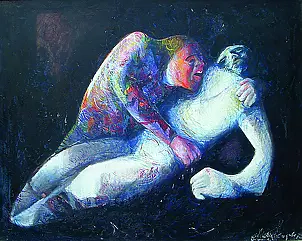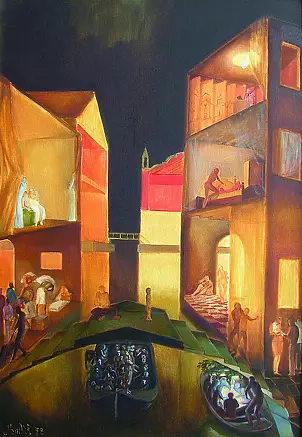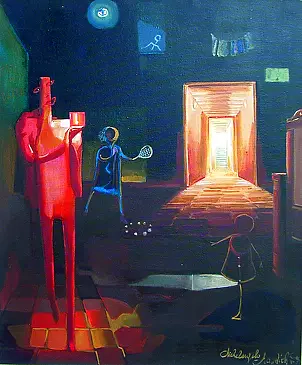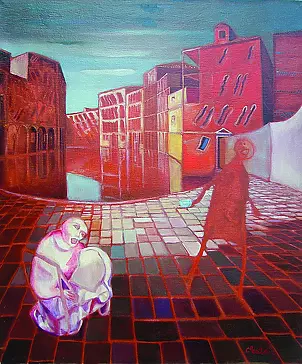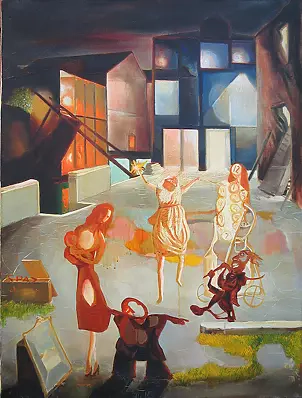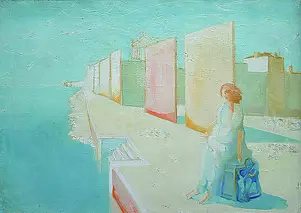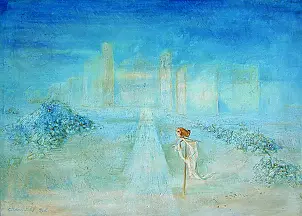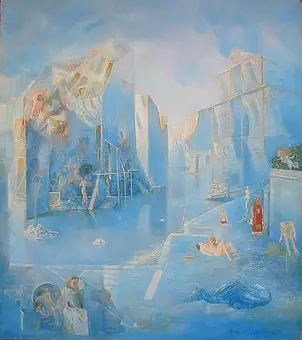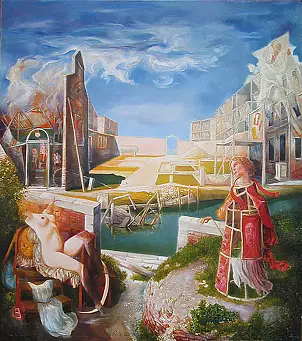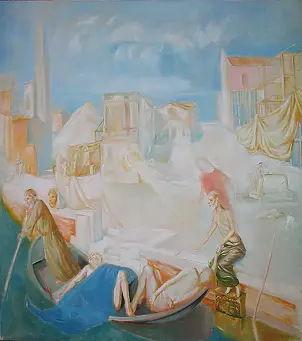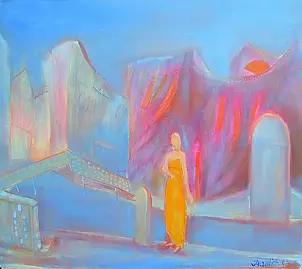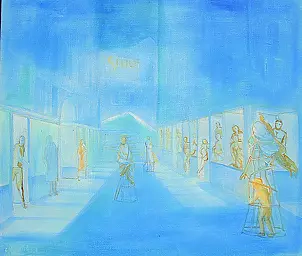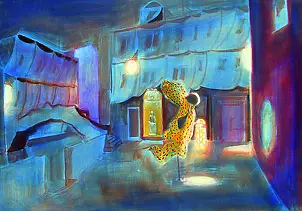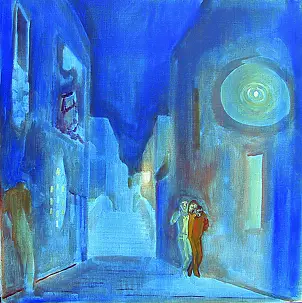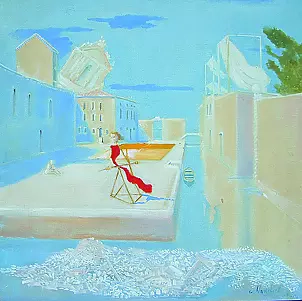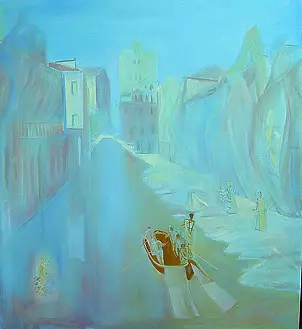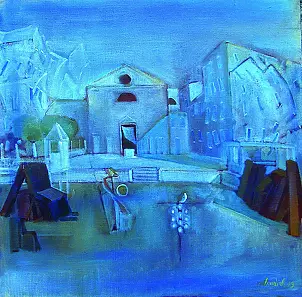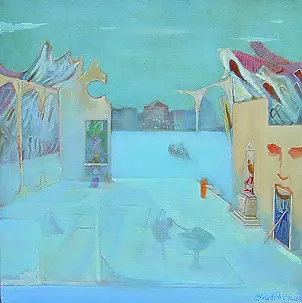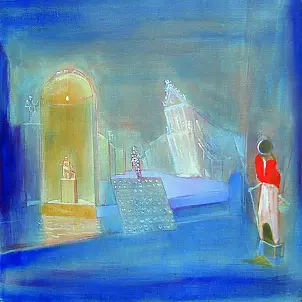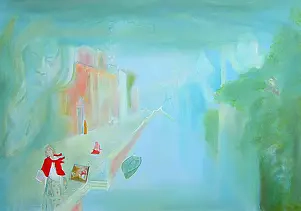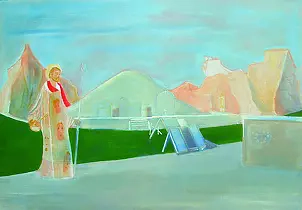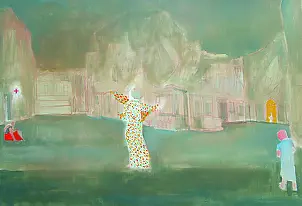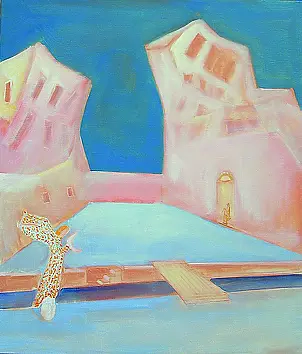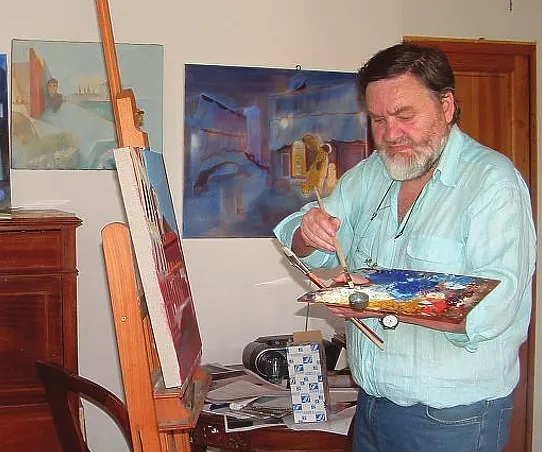
Michelangelo Mandich was born in Venice in 1942. At the age of 8, the family moved to various cities in Italy on account of his father’s job, finally ending up in Rome, where Mandich attended the Academy of Design. Despite these years of wandering, Mandich continued to have strong links with his home town, indeed he has strengthened these over the years. In his mind, Venice is always present and his paintings are strongly influenced by the lagoon city.In 1968 Mandich first showed his works at the Palazzo delle Esposizioni in Rome, as part of a collective art show.In 1973 his works were included in a show dedicated to young artists at the Galleria L’Idra in Rome.In 1980 the famous Italian journalist wrote an article on Mandich.In 1983 he had a personal show in Rome at the Galleria Santa Maria in Trastevere.Various other shows followed, but did not live up to Mandich’s expectations and so he decided to withdraw from the public scene in order to continue his research without being conditioned by fashion and the art critics.He stopped oil painting for a while and worked as a graphic artist, exploiting his skills in watercolour painting.In 1987 Mandich became involved in the Leonardo project on behalf of the City of Rome, producing all the graphic works in the Trajan Markets area of Rome for the “I Mercati Traianei: l’Immagine e la Storia” [The Trajan Markets: Images and History] exhibition.In 1988 Mandich produced a series of images representing the various stages in the construction of a Greek temple for “Dalla Cava al Tempio” [From the Quarry to the Temple] exhibition at the Paolo Orsi Museum in Syracuse (Sicily).1989 saw him busy preparing the reconstruction drawings for various old sites in the archaeological area of Ostia – Trajan’s Harbour. In 1995 Mandich produced all the watercolour drawings used for the tourist information panels in the town of Amelia (Umbria). He continued producing similar graphic works for several years until he decided to return to oil painting.In 2007 after a period of silence, he decided to show hold a personal show open to the public in Rome at Castel Sant’Angelo (Museo Nazionale di Castel Sant’Angelo). The show was presented by Prof. Claudio Strinati, Director of the Rome Museum System, at the Italian Ministry for Culture.The show was a great success with the public, many of whom left messages thanking him for this rare occasion to share in the voyage of dreams proposed by the artist.
Articles on Michelangelo Mandich, the artist:
1) Presentation of the painter, Michelangelo Mandich – Claudio Strinati
2) I have tried to portray Paradise – Michelangelo Mandich
3) Michelangelo Mandich – Ruggero Orlando
Personal Datum : Date of birth: 30/12/1942
Birthplace :Venice - Italy
Nationality : Italian
Education : -Design degree at Academy of Design in Rome 1967/68
- Higher Education - Diploma in Art 1961/1962
Career Goal: To continue to pursue my varied and various art interests , and continue my personal interior research through my paintings
Work experience :
Exhibition
-2009 -Agora Gallery –Chelsea- New York
-2008 - National Museum of Castel S. Angelo-Rome
-1995 - Amelia Town (Umbria-Italy)
-1989 - Archeological area of Ostia – Rome
-1988 - Paolo Orsi Museum in Syracuse – Sicily
-1987 - Trajan Markets Museum – Rome
-1983 - Santa Maria in Trastevere Gallery – Rome
-1973 - Idra Gallery – Rome
-1968 – Exhibition Palace - Rome
Graphic works:
2009 – Twenty portraits of pilots for the Ferrari’s Group, published on the rewiew “L’Espresso”
2008 – Portraits of Italian famous writer for the Italian Ministry for Culture
2009/1995 – Several landscapes for Italian tourist guide and permanent touristic information panels
1995 – Watercolour drawings for touristic information panels for the Town of Amelia
1989 - Watercolour drawings for National Museum of the Forest –Tarvisio (Udin)
1988- Series of watercolour drawings representing the various stage in the construction of the Greek temple for the Paolo Orsi Museum in Syracuse – Sicily
1987 - Series of watercolour drawings representing scenes of the Trajan Markets during the Romans time
!980/70 - Several movies playbills for many production agency in Rome
Documentary works:
1988 – Art Director for the documentary “Dalla cava al tempio (“from the pit to the temple”) produced by Italian Ministry for Culture
1988 - Art Director for the documentary “Pompei and Ercolano” for the Fio-Bei project produced by Italian Ministry for Culture
1986 - Art Director for the documentary “Il Galata morente (“The dying Galata”)produced by Capitoline Museum of Rome
1984 - Art Director for the documentary “The ancient Rome” produced by Italian Ministry for Culture
Other activities:
Drawing up writing for Unesco for the documentary “ Venezia e le sue Lagune” (“Venice and its Lagoons”)
Claudio Strinati
Curator, Rome Museum System
One can’t help but feel that Michelangelo Mandich is the rightful heir - albeit in an unavoidably different age - of the great Venetian painters from the Renaissance. His works bear witness to this fact, as do his poetic declarations, when - talking about himself - he quotes Bellini, Carpaccio, Giorgione and Titian. The sin of pride? I wouldn’t say so, given the fact that Mandich is not a mere citationist who wants to deal with the great figures from the past without due cause, using the same subject matter and painting style. Indeed, almost the opposite is true. Just take the time to consider his broad, variegated artistic career to become aware of this.We thus see that Mandich is a modern painter, drawing on various sources of inspiration, going way beyond simple citationism, which is, in him, merely latent. Mandich, in reality, has been a exponent of Metaphysics and Surrealism, even if there’s no way anyone could put confine his work within such a limited definition. His studies, choice of myths and peculiar style of expression do, indeed, originate from his meditation on the rich heritage of the 1900s. But in no means can he be compared to Giovanni Bellini or Tiziano Vecellio.A pointless exercise. And yet it’s legitimate to refer to these past masters, as Mandich works within the same visual universe as presented itself to the eyes of these masters from the Italian Renaissance. Though, of course, they handled it in the style and with the methods typical of their own time. Mandich, when explaining what inspires him, wrote that he finds it hard, when talking seriously about art, to describe the strict structural, spatial and geometric rules that affect his rhythm and what he means.But that’s the whole crux of the matter.Of the Renaissance ideals, Mandich has kept intact and fully upholds the one that could be called the “balance” – precarious, yet sublime – between the logical/rational organisation of a painting and the absolute freedom of the emotional input and creative enthusiasm. This leads us to realise that Mandich’s paintings cannot be and do not set out to be easy and immediate in their interpretation. All the same, few literary and philosophical explanations are needed to reach the crux of the problem and allow the onlooker to delve deeper.Michelangelo Mandich is not an easy artist. His world of expression draws heavily on myths, often obscure symbols and frequently arcane evocations. But the fascination we feel in seeing his works lies right there, in this interplay of concealment and revelation: two aspects that are always present in this artist’s fervid creativeness. The perfect chance, therefore, this important show, to appreciate this artist’s subtle quality and great determination that emerge from a wide-ranging consideration of his work.
I have tried to portray Paradise...
by Michelangelo Mandich
“I have tried to write Paradise” wrote Pound at the end of his life. I have tried to paint Paradise, my Paradise and, sometimes, Hell, my Hell.I have searched for the symbol, found it, then lost it and now I see it in the distance, but I still see it. I have described my story. I’ll continue to describe it. I sense fireflies of thought fluttering within me, small atoms of feeling - transparent, sweet and melancholic, though sometimes harsh and cruel. Vague sensations, imprecise emotions, that flee in a thought that holds those fragments of poetry. I admire my work for the imperfections in its structure, for my deliberate mistakes, for my checked imagination. My work is the object of meticulous confession that is all too clear to me in certain symbols that I cannot avoid or turn aside, confessions of centuries of Art. This dross and sediment of Art, the shadows, the glimpsed thoughts...I paint church interiors that twist upon themselves and shatter. Adam and Eve arise from the altar-piece... Hephestus in the guise of San Lorenzo searches Aphrodite who is playing with Eros, while the warrior spies on them. Houses and palaces that melt and rise to the heavens... water, fire, air, earth and the wise, thrice-great Hermes. From Malkuth to Kether... a man clambering to peep into the Garden of Destiny and the ensigns thrust into the city walls.I gradually build up my own small universe: neither new nor old, but separate and somewhat strange in its meanings and magical in its evocation and associations. It is difficult to talk about Art, to describe the emotions, impressions and even fragrances that can be evoked by a painting. Or the strict structural, spatial and geometric rules that determine its rhythm and meanings. Occasionally I try to mislead and baffle the spectator with a superfluous detail, having nothing to do with the action taking place in the painting. But the result can always be understood eventually, given that the final overall vision never hides the truth as to my inspiration. There is always a coherent vision of it all within the work, even at the price of absolute concentration.My masters are Giovanni Bellini, Carpaccio, Giorgione and Titian, the acme of painting. I feel very much like a Byzantine painter from the 17th Century would when gazing upon the Greek master-pieces from 5th and 4th Centuries B.C. still to be found in some palace or other of the Basileus in Constantinople.Michelangelo Mandichby Ruggero Orlando The inheritance of Surrealism is proving to be more alive and viable than that of many other trends and avant-garde movements: more and more young artists today are returning to painting with a brush, after “pop” and “op” replaced abstract expressionism and made their own statements. Mandich brings hyperbol to rigorous sensitivity of shade; esoterica dominating subjects by the like of Ernst and Magritte is, with him, coherent with certain brick red shades that evoke spectral atmospheres, even if there is no figure asymmetrically placed in a state of imprisonment or violent death, or a bottled foetus, as can be found in a old Sabbath witch’s den. Michelangelo Mandich’s works thus follow two paths: the sometimes static and desolate, at other times polemical and rebellious evocation of a reality that the hesitant refuse to face, and the play of light and impastos used for the open and closed settings to gain depth and allow the onlooker to go beyond the picture itself. The scepticism felt in Mandich’s works contains, paradoxically, much faith: in the face of evil and shadows, art continues to be a road to redemption.
Pour moi la peinture est...
Descrizione dell’irreale e della metafisica.
Quel était votre premier tableau vendu?
Una veduta di Venezia nel 1960.
Ce qui m'inspire c'est...
La mia infanzia, la mia città natale ed il primo Rinascimento veneziano.
Quelle est votre phrase préférée
Impara sempre il tuo mestiere di pittore.
Raconte-nous quand la dernière fois étais-tu surpris
Nel corso della vita ci sono innumerevoli occasioni per essere piacevolmente sorpresi, basta saperle scorgere. Una di queste è stata nel corso di una visita agli Uffizi , quando osservando la “Sacra Conversazione” di Giovanni Bellini, ho scoperto nuove sensazioni mai provate prima.
La fête n'est pas réusie sans...
Vorrei avere più tempo, perché il tempo passa troppo velocemente.
Je voudrais avoir plus ...
Vedo i giovani appassionati e pronti a lottare per raggiungere un traguardo
Aimes-tu les nuits?
Scriverei.
J'adore quand
immerso nell’amore e nella felicità.
Chat ou chien?
Si tu ne pouvais plus peindre, ...
Plat préféré? ...
Bach, Elvis ou Madonna
Je voudrais passer l'immortalité en étant...

